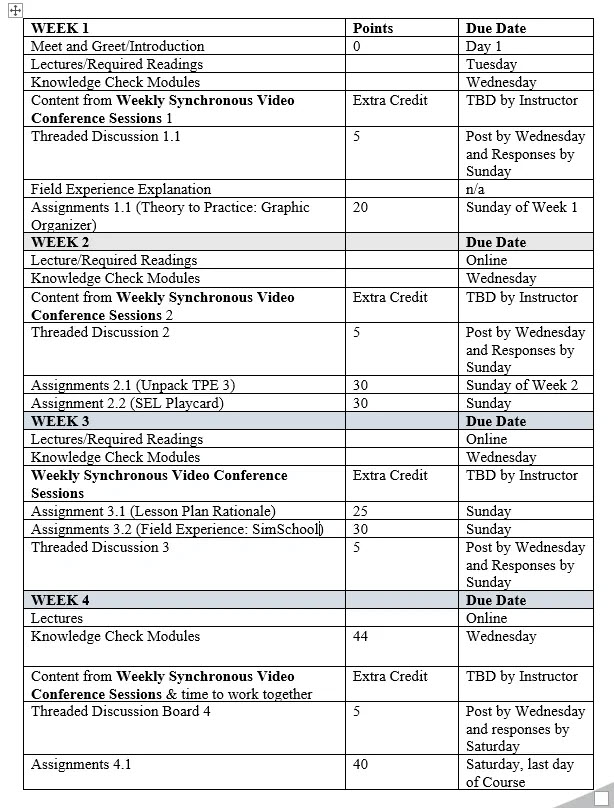ITL606 Learners and Learning II examines theories and research regarding typical and atypical child and adolescent development and learning. It considers various data collection and assessment techniques guiding the selection of effective instructional strategies, practices, resources, and technologies needed to create environments supporting the full range of learners and providing equitable access to the curriculum.
COURSE LEARNING OUTCOMES:
Upon the successful completion of this course, candidates will be able to do the following at an introductory level:
- Compare a variety of learning theories and instructional approaches to meet the unique needs of learners (i.e., individual, small group, and/or whole class).
- Compare knowledge of typical and atypical child and adolescent development in the identification of appropriate instructional services (including methodologies, strategies, resources, and technologies) to support a wide range of learners and ensure equitable access to the curriculum.
- Compare the purposes, characteristics, and appropriate use (and misuse) of a wide range of assessment practices (e.g., formal and informal, formative and summative, progress monitoring, and multi-tiered systems of support, performance, etc.).
- Analyze data from a variety of assessments and data sources (e.g., IEP, IFSP, ITP, 504) and their implications for learning objectives and plans; monitoring student progress; differentiating, making accommodations, and making adaptations; identifying strategies and environmental supports appropriate to the individual student’s success, and incorporating critical and creative thinking.
- Apply effective strategies for creating a learning environment that ensures students (and their families) are treated fairly and respectfully and that addresses issues of intolerance and harassment (e.g., bullying, racism, sexism, etc.) among students and others in the educational community.
COURSE SPECIFIC EXPECTATIONS:
The readings, handouts, and assignments will focus on learning theories, including typical and atypical development and factors of diversity impacting learning; models of teaching based on theory and related teaching methodologies; assessment and other data collection; Universal Design for Learning (UDL) and application of data to address student needs in the selection of instructional methods/strategies and other interventions, and for the graduate level course, classroom management.
- For online course delivery, candidates are expected to regularly log in to the course, participate via Threaded Discussions, participate in weekly synchronous video conference sessions or alternate activities, and complete all assignments identified in the course outline. Attendance of weekly synchronous video sessions is considered extra credit.
This dynamic and interactive course enables the candidate to participate in the following assignments to develop and extend his/her knowledge of instructing students.
Delivery Format and Evaluation
Candidates will participate in threaded discussions, which will focus on topics of the course. Candidates will be expected to participate in each discussion with questions, answers, and comments expressing their opinions and cite sources to support opinions. The discussion prompts are not intended as essay questions but rather to foster dialogue and encourage candidates to express their informed thoughts, as in a traditional oral group discussion. Candidates are required to post one original entry and at least two responses to other postings per threaded discussion question. Grades will be based on the following assignments and points:

Requirements
DISCUSSION BOARD Assignments/Posts/Responses (20 Points Total = 5 pts each Week)
Each week, you will required to respond to a prompt in the Discussion Board (found in Brightspace). You will also respond to two of your peers. You will receive up to 3 points for your original post and up to 2 points for your peer responses. Posts must be made by Wednesday midnight, and peer responses by Sunday midnight. No exceptions. No late work will be accepted for Discussion Board posts or responses to peers.
Discussion Board #1:
Respond via a video reflection.
1. Identify a common core standard.
2. Based on the chosen standard, identify various instructional groupings to best engage and meet the needs of your learners through differentiation practices (consider interest grouping, ability grouping, progress monitoring grouping, think-pair-share, and other instructional groupings).
3. Explain/justify why these chosen instructional groupings will meet the needs of your students and promote engagement during instruction (using what you know about the student’s assets and needs/gaps).
4. Describe how your justification aligns with one or more of the learning theories.
5. Make a connection to a personal example or experience. If you do not have a personal experience, you can use the contextual information below to provide an example.
Make sure your video reflection is at least 3 minutes but no longer than 5 minutes, including all 5 talking points above. and respond (via video) to at least two peers meaningfully.
Discussion Board #2
In preparing for the opening of the new K-8 school, Bartlett Canyon Academy, it quickly becomes obvious to the principal, Ms. Patel, that “something different” will be needed with instructional strategies. Bartlett Canyon Academy is drawing its highly diverse student population from several local communities. Individual differences in educational backgrounds, special needs, and home environments are substantial. Ms. Patel decided to approach her faculty.
“What is the best way to address our problem of such diverse learners?” begins Ms. Patel.
Ms. Díaz, a seasoned sixth-grade teacher, suggests that classes at each grade level be organized into tracks to create high, average, and low groups. Each group then works with the same teacher throughout the day. “The plan makes sense,” declares Ms. Díaz. “Teachers can work with students who have similar academic backgrounds. And, students who do poorly will not be frustrated as they are left behind, while students who do well will not have to feel like they need to wait for others.”
Mr. Yang, one of the kindergarten teachers, disagrees. “Students need to be exposed to a wide range of individual abilities, characteristics, talents, and so on. How can we ever help our students appreciate their own uniqueness and diversity if we continually group them together in a way that is more convenient for us than for them?”
Discuss the ideas presented by Ms. Patel, Ms. Díaz, and Mr. Yang regarding between-class and within-class grouping. What are the positives? What are the constraints? Does the age level of children change with their needs?
Discussion Board #3
Instructions:
1) Watch the following video on various formative assessments: https://youtu.be/gFXbuE-21I4
2) Watch the following videos on various summative assessments:
3) Respond by developing a video (2-5 minutes) or written reflection (1/2 page) of what you learned from the videos. Make sure to state at least 2 unique formative assessments and 2 summative assessments you would apply in your classroom or future classroom. How would you go about developing and implementing these assessments? What barriers do you think you may face, and how would you go about overcoming those concerns?
4) Respond to two of your peers.
Discussion Board #4
1) Respond by developing a video in the Discussion Board that addresses at least 3 strategies or “aha” moments that you found helpful in this course.
2) Respond to two of your peers.
ASSIGNMENTS
Assignment 1.1: Theory to Practice: Electronic Presentation (20 Points)
Create an electronic presentation (Prezi, PPT, Weebly, etc.) on Learning Theories. You must include for each given theory the connections to UDL and also to your current teaching schema of your whole class and your 3 Focus Students (ITL 604). How are you currently using theories in your teaching practices, and which learners are you targeting this learning theory for (who does it provide additional access to?).
You must provide a reference page and have citations throughout your presentation of the learning theories. Be creative – you may use videos, pictures, charts, or other multimedia (be sure to use citations).
Assignment 2.1: Unpack TPE 3 (30 Points)
Review the assignment instructions found under Week 2 for this assignment. Unpack TPE 3 following the directions found on the instructions page. Fill out the template.
Assignment 2.2: Social Emotional Learning: Field Experience (30 Points)
Diversity and Inclusion are the next aspects we will examine in Social Emotional Learning. Learning about who we are culturally as individuals, as a learner, and as a contributor to the classroom, school, and community can build the path to our own empowerment. By implementing supporting Diversity and Inclusion, teachers can create a safe learning environment and improve academics. Explore these four cards to discover valuable practices that impact student-teacher relationships.
- Go to the following website and enter your username and password: https://online.sanfordinspire.org/
- Find the online portal titled “National University – Sanford College of Education” and press “Go Now!” to open it. View the shelf of Playbooks in Social Emotional Learning. For this assignment, you will only need to access Playbook #3, which is called “Diversity and Inclusion”.
- Once you have opened up the “Diversity and Inclusion Playbook, you will have access to the four cards for this Playbook, which will be referenced throughout this assignment and in future courses. Answer the questions from the template found under Week 2 for this assignment. Submit.
Assignment 3.1: Lesson Plan Rationale (25 Points)
Thinking about the class context information and students’ assets and learning needs for the whole class and focus students, briefly respond to the following prompts (no more than 7 pages). Type your responses within the brackets following each prompt. Do not delete or alter the prompts.
Assignment 3.2 (Field Experience: simSchool) (30 Points)
You will click the link under this assignment, Assignment 3.2, to complete the modules on simSchool. Fill out the form and submit your assignment.
Assignment 4.1 Signature Assignment: Teaching/Lesson Plan (40 Points)
This assignment also requires that you collaborate with a group of candidates from your course. It should be started in Week 3. This assignment, due week 4, is a major assignment, the signature assignment, which brings together a variety of learnings from this class. You will be required to identify data (information) about a student, summarize and analyze the data, and make data-based decisions to serve this student’s needs, as well as address the needs of other students in the class and the class as a whole. It is recommended that you review the requirements and formulate a plan early in the course for completing this work. The work can easily take all of the 4th week to complete. It is recommended that all other assignments be completed before the 4th week to allow ample time to work on The Case Study.
Form and Style for Written Work
The form and style of the profession of education and special education is that of the American Psychological Association (APA). For guidance with APA format, an excellent tutorial is available at https://www.apastyle.org/index. To access the website, copy and paste the web address into your browser. Clicking on this particular link may not work. It is recommended you NOT rely on Purdue OWL as it has some guidelines specific to that university.
Collaborate Live Options – Extra Credit
During each week, you will have an opportunity to engage in a live BRIGHTSPACE ZOOM Collaborate synchronous session with your instructor and classmates or an asynchronous experience covering content that has already been presented in your course shell. Please select one of the two options below. Students are highly encouraged to complete option 1.
- OPTION 1 (Synchronous/2 points): Attend the online live BRIGHTSPACE ZOOM Collaborate session that will be held for one hour per the scheduled day and time unless otherwise specified by the instructor.
- OPTION 2 (Asynchronous/2 points): Review the archived recording of the week’s online live Collaborate session and then respond to the following two prompts by clicking on the “Create a Thread” button of the assignment link by Friday or according to a deadline established by the instructor.
- What “aha” moment did you have concerning what was discussed during the live session recording? In other words, what information or concept surprised you or enlightened you, perhaps something you had not understood clearly before or that you had never considered?
- Generate one or two questions based on what was discussed during the live session recording.



